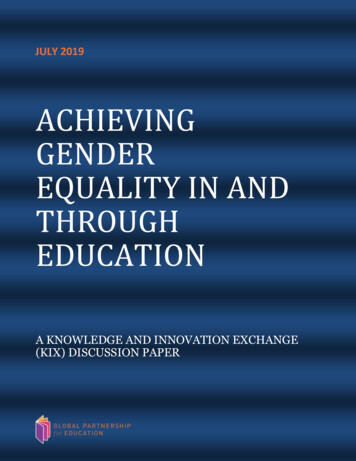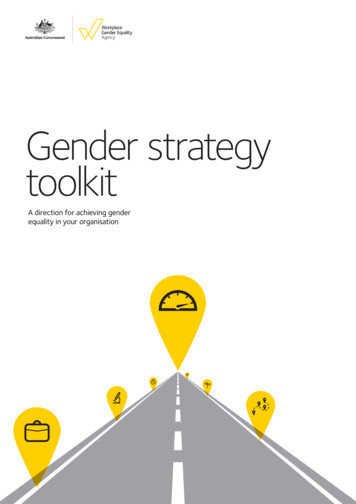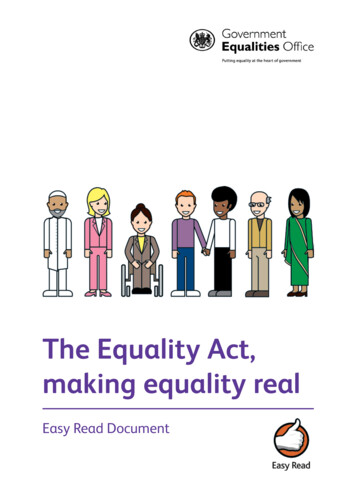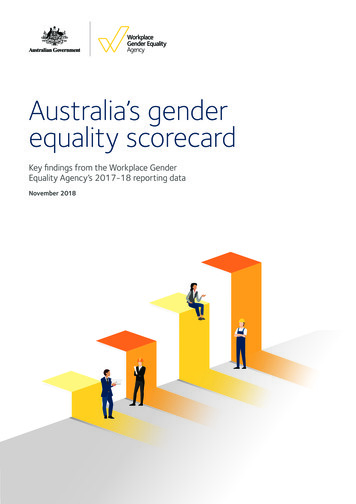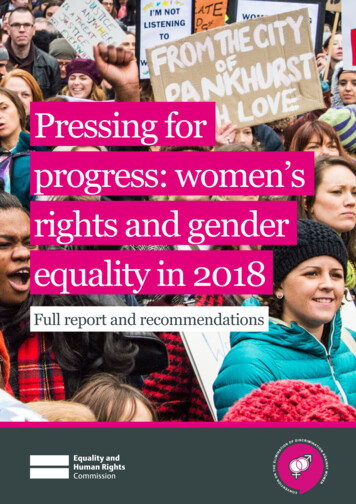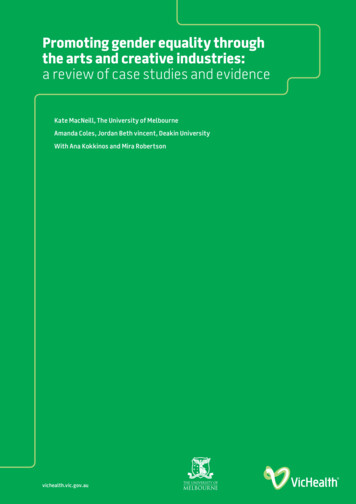
Transcription
Promoting gender equality throughthe arts and creative industries:a review of case studies and evidenceKate MacNeill, The University of MelbourneAmanda Coles, Jordan Beth vincent, Deakin UniversityWith Ana Kokkinos and Mira Robertsonvichealth.vic.gov.au
AcknowledgementsThis report was commissioned by the Victorian Health Promotion Foundation (VicHealth)AuthorsAssociate Professor Kate MacNeill, The University of MelbourneDr Amanda Coles, Deakin UniversityDr Jordan Vincent, Deakin UniversityWithAna Kokkinos and Mira RobertsonWe wish to acknowledge the contribution made by our two researchers: Ana Kokkinos and Mira Robertsonwho drew together the data base of projects and activities on which the report is based, and compiled thecommentary contained in Part Two of the report.
ContentsPART ONEExecutive summary and key findings1Recommendations4Chapter one:Arts and cultural practices and gender equality8Chapter two:A typology of gender equality themes14Chapter three:A typology of strategies and engagement techniques24Chapter four:Findings and Implications for the Victorian context37Appendix: Research strategy42Bibliography47PART TWODetailed list of projectsFrom page 49
Executive summary and key findingsThis report was commissioned by VicHealth and contains findings and recommendationsthat are intended to inform individuals, industry organisations, funders and governments,who seek to contribute to the goal of achieving gender equality through the arts andcreative industries. The VicHealth Action Agenda for Health Promotion (2016–19) recognisesthat gender equality is a critical determinant of health and wellbeing and a fundamentalhuman right that benefits us all. Efforts in this area currently focus on improving outcomesfor women and girls, and the Action Agenda’s approach builds on VicHealth’s strongpartnerships with the health, sport, business, media, research, human rights, education,justice, arts and community sectors. The Victorian State Government’s Gender EqualityStrategy, Safe and Strong, highlights the role that the arts and creative industries can play inshaping gender norms, and thereby the potential to challenge restrictive expectations ofwomen and girls through the same means (Victorian Government 2016).Artists have long been involved in art for social change. Often this is pursued throughindividual art projects, powerful works that have a strong impact on their immediateaudience. A growing commitment to promoting gender equality exists across a range ofsectors in Victoria and the arts are also involved in pursuing and promoting this longoverdue commitment to cultural change.This research examined arts-based projects undertaken across a diverse range of countriesthat had as their primary motivation, an engagement with gender, or had potential to beapplied to this end. Through a study of over 100 projects, and detailed analysis of around30, a range of inspiring, engaging and poignant artistic activities and creative products arehighlighted. These range from intimate interactions in a public space with an elderly womanlying in a bed, to a never-ending game where players collect, confiscate and fire tampons atone another online. Virtual reality is deployed in some projects to provide an insight into thelived experiences of women, as they face harassment walking down a street, or approachingan abortion clinic. Other projects empower young women within the music industry, both asproducers and as audience members at concerts and festivals.Promising approaches to audiences and strategic partnerships in initiating, funding andproducing projects, are highlighted, demonstrating the potential for small projects to reach1
wider audiences, and for large projects to be realised through shared investment on thepart of government and corporate support.The report consists of two parts. Part One contains an analysis of arts projects, highlightsparticularly effective initiatives in the arts and creative industries, and presents a set offindings. Part Two contains details of over 40 projects and organisations that representpromising approaches to gender equality or, if not specifically related to gender equality,that adopt strategies that could be used towards gender equality.Aspects of gender equality pursued through the arts and creative industriesThrough an analysis of over 100 projects we identified the following roles that theseprojects played in intervening into areas of gender equity.1. The arts proved to be a useful vehicle for providing an illustration of what it is like toexperience the world as an ‘Other’. This was achieved through immersive technologiessuch as virtual reality, which provided men with the perspective of being a woman in ahostile male environment.2. The arts are a crucial mechanism whereby identities are formed and performed, andhence are an important vehicle whereby gender stereotyping can both be reinforced,and disrupted, with arts projects exploring different ways of being a man or a woman, orindeed disrupting the notion that one must be either.3. The arts fulfil a significant role in terms of telling stories about our past, our present, andour futures, and as such it is crucial that the stories being told are inclusive of thediversity of gendered experiences.4. The arts can be a site for truth telling; revealing aspects of cultures and behaviours thatmight otherwise be taken for granted. Most notably, it can shine a light on unhealthyand unsafe environments that can be found in exclusively male or highly maledominated sporting clubs, workplaces and environments.5. The arts allow for, and validate, self and collective expressions and are a means wherebyfulfilment is gained through being heard and being visible in public spaces. Hence allsections of our communities, howsoever identifying in terms of their gender andsexuality, must be seen and heard within our public performance and displays of art.2
Maximising engagement and impact of projectsWe identified techniques, and design consideration that contributed to the impact achievedby particularly innovative projects.1. The design of a project should consider not only the intended audience for the project,but also the potential to broaden the scale and geographic scope of an audience throughadditive technologies, and components.2. Technology enables arts projects to deliver outcomes to initial audiences far beyondthose within an immediate community.3. A key factor in an artwork or project seeping into the public consciousness is its‘durability’.4. Durability can be heightened through extension into other media, scaling the projectthrough enabling much wider participation than in the initial production, or a selfreproducing cycle of performances.5. Art projects can have long term impact through leaving a legacy of skill and/orinfrastructure that is enjoyed and deployed far beyond the life of the immediate project.PartnershipsThrough examining the range of organisations involved in the projects we identified the keyrole that partnerships played in both realising and extending the audiences of projects.1. Arts projects can leverage content generated through existing gender equality research,campaigns and documentation, sourced through partnerships with universities,government, public health and social change agencies.2. Corporate partners can provide financial support, in-kind support and co-investmentwhen the arts projects align with its commercial and brand interests.3. Gender equality projects that had a diverse range of cross-sectoral partnerships, e.g.with universities, established arts organisations, corporates, and non-governmentorganisations had the capacity to extend beyond immediate target audience.3
RecommendationsThis section contains a range of recommendations to inform future activities in this area onthe part of organisations, agencies, funders, and practitionersSocial practice art1. Frame a call for projects that engage with gender equality through partnering anestablished social practice artist with an established arts organisation and/or festival.The key element is that the artist has a significant reputation that will ensurepublicity and interest beyond those that are usually attracted to arts projects. Thismight mean approaching a small number of artists and inviting them to submit aproposal as one would with a major public art commission.Partnerships2. Pursue sponsorship or pro bono support from, or partnerships with, corporationswho share a commitment to gender equality to produce projects and interventionsthat reach the widest possible target audience. The principal targets for suchpartnerships are likely to be media and public relations companies, legal andfinancial companies who may be seeking to assert their gender credentials, andscience, technology, and engineering companies who can both provide in-kindsupport for digital developments and have their own interest in gender equality interms of recruitment.Collaborative funding3. Develop a collaborative funding program with funders who are already activelyengaging with issues of gender equality in the arts and creative industries.Collaborative funding will (a) encourage more strategic policy thinking about thevalue of the arts for promoting gender equality across a range of portfolios/agencies;(b) put gender equality on the arts programming agenda; and (c) encourage thedevelopment of projects that have a wider footprint and longer life span than mightbe achieved through a single source of funding.4. Build evaluation into the design of the collaborative funding project, and indeed allprojects for social change. A dedicated evaluation team would evaluate both thefunders collaborative as an experimental funding strategy to promote gender4
equality through arts programming, as well as the impact and value of the fundedprojects. Evaluations would assess the degree to which a project connects with itstarget audience, the proportion of the target audience that it reaches, the longevityof the project and its legacy.Higher education partners5. Establish forms of co-investment with innovative creative industries partners toextend the reach and sophistication of creative projects working with and for genderequality. A partnership between higher education institutions, technologycompanies, arts organisations and key interest groups could explore the potential ofarts and creative industries projects to build empathy and raise consciousness. Thiscould be pursued through an Australian Research Council (ARC) linkage project.6. Partner with academics and with sporting associations to commission a documentaryon sport and gender equality, which would also encompass recent and groundbreaking discussions about the eligibility of trans and intersex athletes to compete atelite levels, to say nothing of highlighting the success of Australian sportswomen.This too could be the focus of an ARC Linkage grant, as it would require a rigorousresearch component.Crowd sourced content7. Build a network of artists and creative practitioners who will devise shortperformance pieces drawing on crowd sourced anecdotes of gendered experiences.Commencing with a call for short stories, these could then be performed asimprovised sketches and ultimately be incorporated into an event which could becalled Random Acts of Gender, combining the successful elements of Random Acts ofCulture with those of For One Day All St Paul’s a Stage.Screen/media content8. Develop creative products that can be shown at screen-based venues and events.The Representation Project’s trailer is an example of a powerful short message aboutequality of representation. The documentary Her Sound Her Story, has potential tobe seen by a large audience and could be the impetus for additional profile of genderequality activities in the wider community and/or adapted to include womenmusicians from the Asia Pacific region for maximum international impact.5
Project specific partnerships9. Promote creative development within specific arts and creative industriesorganisations and funders, in ways that promote gender equality, such as:a. a gender equality themed short film competition in conjunction with theMelbourne International Film Festival (MIFF) and FilmVic that would thenshowcase top quality productions during MIFFb. a gender equality script development project for film or theatrec. a commission for a work of public art in a prominent public space such asFederation Square, Spring Street, or outside Town Hall that engages withissues of gender equality. The process itself could create a lively communityconversation – as proposals can be put on public displayd. a collaboration with Museums Victoria to identify gaps in the stories it tellsabout women, and to expand its outreach and education capacities in thearea.10. Include education partners, artistic and creative personnel, and distribution partnerand or channel to extend project reach, scale and durability in all gender equalityprojects:11. Encourage a major construction company/project – (Metro Tunnel, East West Link);or media companies – to commission street art on prominent building sidings andbillboards.12. Partner with sporting associations to gain access to specific target audiences, forexample enlist a football league to incorporate a presentation at a Grand Final thatinvolved footballers – male and female – reading out empowering stories of genderdiversity drawn from fan’s contributions.13. Invite digital media practitioners and start-ups, such as Girl Geek Academy to exploreways in which street art that intervenes in or disrupts gender stereotyping can reacha wider audience through digital distribution, YouTube, Instagram and social media.Scaling/stretching projects14. Identify existing creative projects that address gender equality with a view to scalingup the activity for a wider audience and impact. Projects will have alreadydemonstrated success and may only require minimal additional funding to present6
the work in an alternative medium which will reach wider audiences and be part ofwider conversations.15. Explore ways in which street art that intervenes in or disrupts gender stereotypingcan reach a wider audience through digital distribution, including YouTube,Instagram and other social media platforms.Monitoring and evaluation16. Monitor gender equality in the creative output of the arts and creative industries.This could be by way of highlighting the regular reports produced by The CoUNTessReport and The Stella Count, and instigate a comparable project to that of theBechdel test measuring the gender representation in cast and content in Australianfilm and/or theatrical productions.17. Devise a methodology that will enable evaluation of the impact of arts projects thatseek social change outcomes, and ensure that factors that contribute to impact anddurability are built into such projects from the outset.7
Chapter one: Arts and cultural practices and gender equalityArts and cultural practices play a complex role in relation to gender equality. As noted in the2016 report produced by Culture Action Europe, questions of gender equality raise thefundamental issue of ‘who in the community holds the power to define its collectiveidentity?’ (Pujar 2016, p. 7). Viewed from this perspective, arts and cultural production areused to define cultural and collective identities. The arts can both reflect inequalities thatare present in a community, and can, in the absence of an intervention, perpetuate theseinequalities through the persistence of images and stories. This is the first basis on whichgender equality matters in the arts and creative industries: it is a measure of the degree towhich our cultural content enables all members of the community, or population, to findthemselves in forms of collective cultural expression, and to expand thinking more broadlyas to what is possible or achievable by all members of society.The arts are also an important vehicle through which individuals tell their own stories, tofind freedom of personal expression, and to be able to see one's own identity reflected incultural and creative expression. This plays an integral part in creating a sense of individualwellbeing and belonging. If gender equality does not exist amongst content producers in thearts and creative industries, then its cultural products and the experiences offered toparticipants and audiences will fail to embrace the full gender diversity of our community.This is the second basis on which gender equality matters in the arts: it determines thedegree to which men and women fulfil their own right to artistic expression through selfrepresentation, telling their own stories, and making an individual contribution to thecultural and creative landscape.The purpose of this research project is to identify and document an international evidencebase of arts and creative industry programs and initiatives that could be used to promotegender equality in the Victorian community. The primary audience for this review is policymakers, funders and arts and culture makers/shapers in a range of sectors (creativeindustries, government, health, NGO), and it is intended to inform future gender equalityprogramming, investment opportunities and research. The research has been undertakenwith a view to providing strategies and projects that might be adopted at a range of levels inthe community. To this end we have focused on a wide range of arts-based projects that8
were designed to have an impact on gender equality, and an understanding of genderfluidity, at an individual, community and societal level. These range from local communitybased activities, to major participatory art events and multi-sited global projects usingdigital technologies. Case studies have been drawn from a variety of cultural settings,however out of necessity we have relied only on English language documentation, which haslimited the geographic scope of the project. Rather than a comprehensive audit of all suchactivity – a somewhat unrealistic task – we have sought to present snapshots of practicesthat might be scalable, translatable, and viable in a range of Victorian settings.The review is designed as an inquiry into gender equality, which implicitly opens upquestions regarding gender diversity. This both highlighted the need to acknowledge genderis no longer perceived to be a male/female binary, but also drew attention to the diversityof masculinities and femininities. VicHealth recognises the diversity of Victorian women andthe significant social and economic disadvantage experienced by a number of groups ofwomen, including Aboriginal women; women from culturally diverse communities; womenwith disabilities; lesbian, bisexual, trans and intersex women; women with lower incomes oreducation levels; and women living in rural and regional areas. The broad range of projectsthat are presented are therefore chosen because they address or have the capacity to beadapted to engage with, a broad range of women and encompass the realities of theintersectional pressures that impact many women’s livesArts and creative activities have been widely adopted as a mechanism to work withdisenfranchised and minority communities to empower and build resilience and wellbeing.This begs the question of how to intervene, and indeed where to intervene to encourageshifts in aspirations, attitudes and the broader imaginaries of women and men. The shortanswer is everywhere. To this end, we have brought together interventions that seek toachieve gender equality amongst our cultural producers, and that have sought to achievegender equity through cultural activities.The policy environmentIn 2016 the Victorian government adopted Safe and Strong: A Victorian Gender EqualityStrategy: a strategy for state-wide action through alliances and partnerships to delivergender equality. The strategy noted that gender inequality can be compounded through9
other forms of disadvantage and discrimination, and noted particularly that Aboriginalwomen, women from culturally diverse communities, women in rural and regional settings,women with disabilities, and trans and gender diverse people are likely to experiencegreater economic inequities and face direct discrimination (Victorian Government 2016).Research on the prevalence of violence against women highlights the role that the unequaldistribution of economic resources and power along gender lines plays in perpetuatingviolence (CHANGE 1999, Heise 1998). As quoted in the VicHealth publication Preventingviolence before it occurs, Heise observes ‘any analysis of violence (against women) mustrecognise the primacy of culturally constructed messages about the proper roles andbehaviour of men and women and the power disadvantage that women bring torelationships by virtue of their access to power and resources’ (VicHealth 2007).Influenced by this research, Change the Story: A shared framework for the primaryprevention of violence against women and their children in Australia (Our Watch 2015),highlights that ‘gender inequality is at the core of the problem and it is the heart of thesolution’ and highlights that factors including ‘beliefs and behaviours reflecting disrespectfor women, low support for gender equality and adherence to rigid or stereotypical genderroles, relations, and identities’ predict or drive violence. The Victorian government strategyhighlights the role that ‘idealised depictions of women’ and ‘rigid constructions ofmasculinity and femininity’ play in contributing to unhealthy, and violent, relationshipsbetween men and women (Victorian Government 2016, p. 31). Change the Story outlineskey sites that can influence cultural change – long term investments in all those placeswhere we live, work, learn and play will be required. The arts and popular culture areidentified as an important site to support and influence such a cultural shift towards greatergender equality (Our Watch 2015, p. 38).The focus of this paper is on art practices that promote, or have as their aim the promotionof, gender equality or changing people’s attitudes to gender equality. In so doing, thesepractices can in some way shift power and resources by enabling women and men toimagine and realise different ways of being in the world. An emphasis is placed on practicesas other sectors will be taking the lead on gender segmentation and representation at anindustry level. The Australian arts community, and those engaged in social change advocacymore generally, have embraced participatory arts practices as a mechanism to expand10
audiences and, more particularly, as a way in which individuals and communities can findspace to collectively shape culture. The art practices examined include, but are not limitedto, participatory practices that seek to create transformative experiences. We also includelarger scale projects that have the capacity to change the public debate beyond the reach ofany single participatory project, and small-scale projects that, through innovative use oftechnology or by way of a strategic intervention in the value chain, become self-generating.If gendered constructions of masculinity and femininity contribute to gender inequality,then it follows that these assumptions can be reduced or dismantled through alternativedepictions of gender. We know that attitudes towards gender are formed early in our lives,and, furthermore, that they are not innate. Research conducted on the perception of theirown gender, and the perceptions of others on their own gender, undertaken with preschool children, found that watching television had an impact on children’s considerationsof what other people thought about their gender. A child who consumed daily amounts ofbetween three to four hours of television is ‘twice as likely to say that others think boys arebetter compared with a child who watched no television’ (Halim et al. 2013).As noted in Change the Story, ‘the arts are a valuable medium for exploring and challengingsocial norms and encouraging community participation’ (Our Watch 2015,p. 39). Perceptions of gendered roles and rigid binary definitions of gender are transmittedand subsequently reinforced through media, culture and the arts. The report proposes astrategy to attack gender inequality more generally and draws together drivers of violencedirected at women: women's lack of independence, limited through male control ofdecision-making; rigid gender stereotypes and constructions of masculinity and femininity;and male peer relations that emphasise aggression and disrespect towards women. Thesekey drivers have also informed our analysis of the way in which projects in the arts andcreative industries can address gender inequality in society more generally.Scope and qualificationsA thorough search of projects in the arts and creative industries was undertaken relyingpredominantly on desk-based data searching and searching of key terms, augmented byspecific reports and scans of activities of known stakeholders, such as arts councils,foundations, and industry organisations. This produced an extensive data base of projects,11
which were then reduced to those arts and creative industries projects that met our criteriaof being either related to gender equality or containing strategies that could be adapted topursue gender equality. The search strategy, together with a summary of the selectedprojects, organisations, and/or activities, is set out in Appendix A. It is important to notethat the projects examined in the course of this research do not constitute a completecompendium of gender equality projects in the arts. Rather they are indicative of the typesof arts and cultural industries activities and projects that seek to enhance gender equality.Details of the projects are contained in Part Two of the report, and it is intended that thismight operate as an ongoing documentation of gender equality projects in the arts andcreative industries with additional projects added to over time.The focus of this report is more specifically targeted at participation in, and experiences of,the arts and creative industries. The Victorian Government’s Gender Equality Strategy, Safeand Strong, acknowledges that the culture within the creative industries is also in need ofchange. It notes that young women and girls have high participation rates in the creativeindustries. However, the opportunity for advancement to leadership and decision-makingroles appears limited and the incumbents in these positions are overwhelmingly male(Victorian Government 2016, p. 32). While a focus on employment patterns within the artsand creative industries sector is beyond the scope of this project, it is unfortunately the casethat the arts sector itself contributes to a lack of economic independence on the part ofwomen through its employment profile. Furthermore, the report observes that a significantmajority (70%) of nominees for Australian arts awards are male despite the number of menand women being roughly equal within the artist population, and that less than 25% of allfilms are about women or include women as principal characters (Victorian Government2016, p. 32).Nonetheless, it is critical that in addressing issues of gender inequality in the communitymore broadly, we do not reproduce it within the strategies adopted. In other words, if ourfocus is on achieving gender equality in all areas of the arts and cultural sector then allinterventions must aim for gender equality within these initiatives. The arts and culturalsector is an important mechanism whereby stereotypes are produced and reproduced, andcan be equally powerful in terms of undoing, and recalibrating gender norms. In recentyears there has been a greater recognition of the constructed nature of the gender binary12
itself. A reference to gender diversity alludes to this. It reminds us that not only aregendered stereotypes harmful in that they assume that there are a limited range of possibleways of being a man or being a woman, but that the very assumption that one must eitherbe a man or a woman has been overtaken by a recognition of gender as a fluid process, andidentity as a work in progress.13
Chapter two: A typology of gender equality themesIn this chapter we present a typology of the range of gender equality themes that wereexplored in the artistic and creative projects examined. These projects sought to achievegender equality (i) within arts and cultural sector’s creative output; and (ii) throughparticipation in and engagement with arts and cultural activity. Together with the analysis inthe following chapter, it leads us to a series of findings, able to assist in developing aframework for devising of projects in the Victorian context, adopting strategies fromelsewhere but translating these to the local context and local set of challenges.Empathic experiencesSeveral compelling projects created an experience that sought to create for a viewer anexperience of everyday life of being a woman in a masculinised culture. These projectsranged from giving a perspective on sexual violence from the point of view of a female, tothe everyday harassment that girls, young women and indeed all women face in publicspace, and the excruciating experiences that arise in a workplace when subjected to‘mansplaining’. The technologies utilised included virtual reality, ironic billboards,performances and storytelling.The strategy of putting people through the everyday experience of the ‘other’ is used in avariety of settings to engender empathy and support. Empathy-based activities arefrequently adopted in rape prevention programs (Foubert and Perry 2007; Foubert andMasin 2012). We had initially sought to identify these projects as examples of ‘walking amile in her shoes’. The phrase has been adopted as a rallying cry for men’s marches inprotest at violence against women and seeks to engender empathy
Artists have long been involved in art for social change. Often this is pursued through individual art projects, powerful works that have a strong impact on their immediate audience. A growing commitment to promoting gender equality exists across a range of sectors in Victoria and the arts are also involved in pursuing and promoting this long



